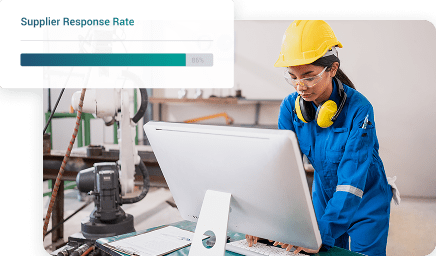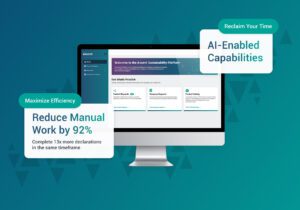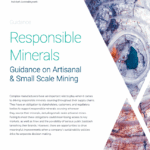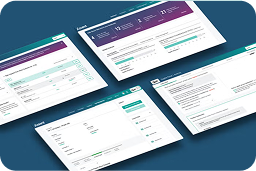Investigations into human right violations from the mining of tantalum, tungsten, tin, and gold (3TGs) — also known as conflict minerals — have caught the attention of regulators and non-governmental organizations (NGOs). Various laws, including Section 1502 of the Dodd-Frank Act, and templates like the Conflict Minerals Reporting Template (CMRT), were created to enforce responsible minerals sourcing in manufacturing.
(Need a refresher on what is responsible minerals sourcing? Check out our short knowledge article.)
But over the past few years, cobalt, copper, graphite, nickel, mica, and lithium (extended minerals) have also been tied to supply chain sustainability concerns like forced labor and child labor.
To protect against supply chain risks and meet growing customer demands for sustainable products, manufacturers must now expand their responsible minerals sourcing policy beyond the 3TGs.
These six steps can help you create a proactive responsible minerals sourcing program for your organization and minerals supply chain.
1. Assess Suppliers for Extended Minerals & Conflict Minerals Use
The first step to designing a responsible minerals sourcing due diligence program is to determine which suppliers and products are in scope of responsible minerals requirements.
Your goal is to identify suppliers in your supply chain that provide consumer-facing goods containing a conflict mineral or extended mineral. Read our mineral sourcing Q&A with two supply chain sustainability experts to learn more about how they’re different.
A thorough scope analysis, usually conducted in collaboration with members of your engineering and procurement teams, will contribute to an efficient program launch by significantly reducing the number of suppliers that need to be contacted.
You might have thousands of suppliers, but many of them will not be in scope. They may be service providers (such as lawyers or accountants) or supplying you with products that are not used in consumer-facing goods (like janitorial supplies). You don’t need to survey these suppliers about their mineral supply chains.
Other suppliers might provide goods that do not contain minerals of concern (e.g., wood or plastic products), and you can omit them from your mineral due diligence program.
Once you’ve narrowed your list to the suppliers that use minerals covered by conflict mineral regulations, you can move on to the next step.
2. Create Responsible Minerals Sourcing Policies
The next step is to create an end-to-end responsible minerals compliance plan and determine the processes required to support it. This may include:
- Determining Production Steps: First, detail all production steps throughout the supply chain in chronological order to help establish what the compliance plan should include and/or address.
- Set Due Diligence Standards: Standards should include a combination of in-house expectations that consider internal company goals and capacity, as well as internationally recognized standards such as the Organisation for Economic Co-operation and Development (OECD) Due Diligence Guidance.
- Communicate & Delegate: Break standards down into steps that can be assigned to specific personnel. The due diligence plan, its goals, and the expectations of associated individuals and groups must be clearly communicated to all suppliers, operational employees, managerial staff, executives, and board members.
- Monitor & Measure: Consider how to measure and report progress on your short-, medium-, and long-term responsible minerals sourcing goals, and how to communicate these results internally and to the public.
Continuous Improvement: Regularly review achievements against due diligence goals. Regulatory requirements may evolve throughout compliance cycles, so changes to the program may need to include new due diligence activities within established operations. For example, if the Responsible Minerals Initiative (RMI) updates the CMRT or Extended Minerals Reporting Template (EMRT), you may need to update your supplier surveys.
3. Gather Supplier Contacts
Next, collect contact information for the compliance officers who represent your suppliers. This is generally the first challenge associated with responsible minerals data procurement.
A manufacturer’s procurement division will have the most up-to-date supplier contact information, but these are usually sales contacts or generic emails for placing orders. Look for a contact who is knowledgeable about the product’s content. If this information is not readily available, a message sent using the contact page on the supplier’s website may, in some cases, be directed to the appropriate personnel. However, receiving a response may take longer than anticipated when using this method.
Once the appropriate contact information is found, it should be added to a central database that can be shared among business units for maximum efficiency. Establishing this database will involve multiple departments, including the procurement, engineering/design, and compliance sectors, at minimum.
4. Engage Suppliers About Their Mineral Sourcing Practices
Once the correct contact information has been found, supplier outreach is the next step. This step may involve significant amounts of data, depending on your supply chain, and is best managed with supply chain management software.
Ideally, a manufacturer will notify suppliers of an impending responsible minerals data request via email. When using a third-party vendor to manage this process, this notification email is essentially an authorization email, which ensures:
- The right person is contacted
- The request is not unexpected
- The third-party vendor (if applicable) has the company’s authorization to procure this data from its supply chain
- Suppliers know what format they should submit their data in (e.g., through a portal, using a template such as the EMRT or CMRT, etc.)
Some suppliers may be hearing about responsible minerals requirements for the first time, so it is important that data requests provide suppliers the information and resources they need to respond efficiently.
Be sure to include:
- A clear, polite request explaining why the data is needed
- A link to the form or survey they are required to complete
- A link to educational materials
- Clear instructions on how to correctly complete the request and by when
- A point of contact for questions
- Links to key resources
5. Track Supplier Progress
When collecting extended or conflict mineral sourcing data, companies often receive waves of responses, depending on the size and readiness of their suppliers. In order to manage the process efficiently, we recommend:
- Keeping information in a centralized location to ensure efficiency of supplier communications
- Maintaining records of the information suppliers have provided to ensure they are not contacted multiple times for the same data
- Measure the time required for responses and consider automated solutions for supply chains larger than 100 suppliers
- Ensure the process can be replicated easily for new regulations or substance restrictions

These best practices for responsible minerals don’t have to be manual and time-consuming. Assent’s conflict minerals reporting software and the Assent Sustainability Platform automate all these steps, making it possible to run your responsible minerals sourcing program with minimum internal resources.
6. Analyze & Report Data
To maximize efficiency, companies should monitor and analyze data as it is collected rather than at the end of the process. The simplest approach to data analysis is with a data aggregator that shows all survey responses or questions at once. If there is no automated mechanism in place for responses, establish a manual process for reviewing, tracking, and analyzing data.
Once data has been collected, companies enter the reporting phase to complete the process for the first year. For reporting under the Dodd-Frank Wall Street Reform and Consumer Protection Act in the U.S., for example, organizations are required to annually file a Form SD with the Securities and Exchange Commission. Other regulations, such as the EU Conflict Minerals Regulation, may require different approaches that are determined by the enforcement authorities of each country.
While many manufacturers have already adopted cobalt sourcing into their responsible minerals programs, the OECD has also proposed more than 30 other minerals for which companies should follow similar sourcing processes. Manufacturers that voluntarily collect data on one or more of these minerals can refer to the OECD Due Diligence Guidance on the topic for information on analyzing their data and how to proceed when risks are identified.
Why Make Responsible Minerals Sourcing a Priority?
Once these six steps have been completed, organizations enter the maintenance phase of compliance. This involves improving and expanding due diligence activities in response to changing consumer, corporate, and legal expectations. This important step helps manufacturers maintain their responsible minerals compliance programs, ensuring their compliance strategies and associated regulatory knowledge are up to date.
Companies seeking to meet their evolving regulatory requirements face considerable challenges, and failure to adapt can result in serious legal, reputational, and financial consequences. By creating and maintaining a strong, expansive due diligence program, manufacturers can identify risks in their supply chains and protect against the adverse effects that can result from their mineral sourcing activities.
Additionally, factors other than regulations for mineral sourcing are constantly increasing, adding complexity. Some minerals are impacted by sanctions, others by export restrictions or tariffs. All of these pose an increased risk for supply chain disruption if your sourcing insights are limited.
Although responsible minerals sourcing requirements vary around the world, the messag
e to businesses is clear: Comprehensive due diligence is imperative for companies looking to maintain ethical sourcing practices.

The Solution: Conflict Minerals Reporting Software
Assent makes running your responsible minerals sourcing program and reporting simple and more cost-effective than manual management. Our conflict minerals reporting software gives you everything you need to collect minerals sourcing data and roll it up into compliance or responsible sourcing reports.
The Assent Sustainability Platform automates supplier outreach and data management, making it easier for you and your suppliers to rapidly share minerals sourcing declarations. And our team of responsible sourcing experts keeps your program up to date with the latest changes in conflict minerals requirements and when new minerals are added to the list of extended minerals of concern.
Most importantly, working with Assent grants you access to our smelter library, providing you with country of origin data, sustainability insights, and risk factors like ties to sanctions on the smelters in your supply chain.
It’s time to take action and hit your responsible minerals sourcing goals.
Responsible Minerals: Assent Answers the Top Questions
Compliance with SCIP and responsible minerals requirements can feel overwhelming, especially as regulations expand beyond traditional conflict minerals. This FAQ gives compliance managers clear, practical answers to common challenges in building and maintaining a responsible minerals sourcing program.










